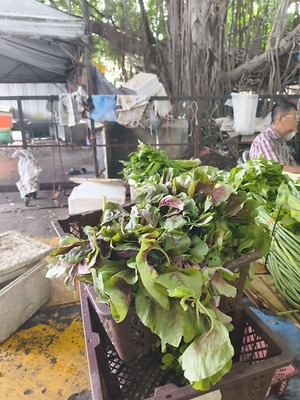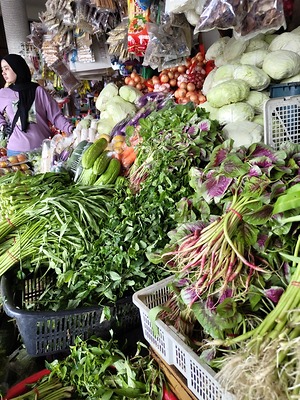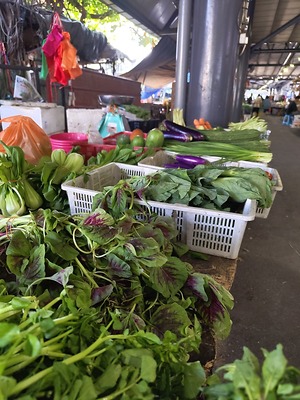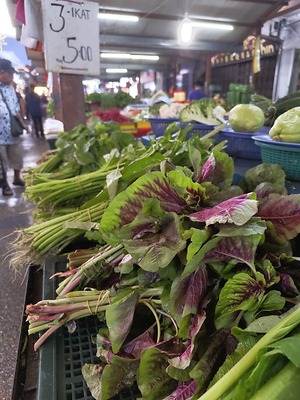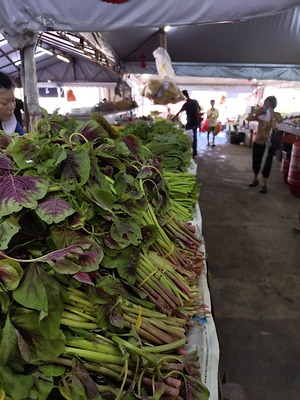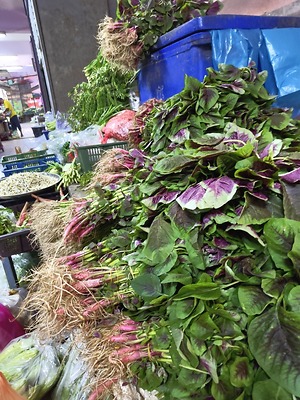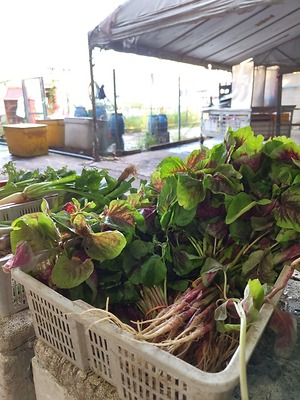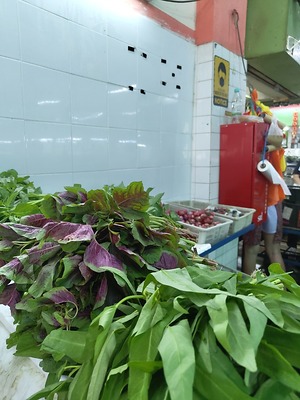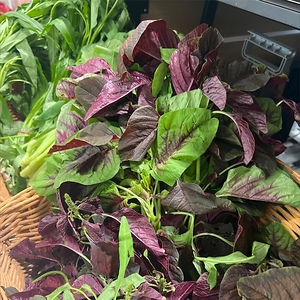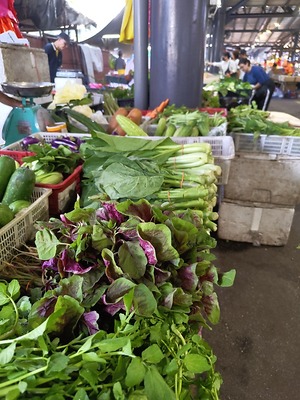


Chinese Spinach
Estimated Inventory, bunch : 0
Description/Taste
Chinese spinach is an upright, leafy green comprised of branching stems with small to medium-sized oval to lanceolate-shaped leaves. The bright green stems are thick, fleshy, and crunchy at the base, becoming more slender, thin, and crisp closer to the leaves. The leaves have a somewhat uniform appearance with even edges and tapered, pointed ends, and the leaf's surface is smooth, glossy, and pliable, with a chewy, tender, and succulent consistency. Chinese spinach greens are found in solid green hues, or they are dark green with splashes of maroon, dark purple, and fuchsia overlaid in the leaf's center. The leaves also have prominent veins scattered across the surface, showcasing raised veining on the undersides. When raw, Chinese spinach has a mild, neutral, vegetal, nutty, and subtly sweet taste. Cooked greens develop a mellow, sweet flavor and tend to absorb the essence of accompanying ingredients.
Seasons/Availability
Chinese spinach is available year-round.
Current Facts
Chinese spinach, botanically classified as Amaranthus dubius, is a specialty culinary green belonging to the Amaranthaceae family. Despite its spinach moniker, the name is actually a descriptor used for amaranth greens, specifically Amaranthus dubius. There are two main types of amaranth greens labeled as Chinese spinach: leaves that are solid green and green with variegated fuchsia and red hues. Variegated amaranth greens are the most common type sold under the Chinese spinach name in fresh markets. Chinese spinach is grown worldwide and is a favored summer green that thrives in heat and humidity while resisting bolting. The greens are known by many names, including Red Yin Choi and Green Yin Choi in Cantonese. Chinese spinach is also known as Xiancai in Mandarin, Bireum in Korean, Yin Tsoi, Hsien Tsai, Bayan, Hon-Toi-Moi, Hiyu, Arai Keerai, Red Calaloo, Spleen Amaranth, and Chinese Multicolor Spinach. Chinese spinach is extensively grown and used as a culinary ingredient in both fresh and cooked preparations. The leafy plants can reach up to 1.5 meters in height and are harvested approximately 30 to 40 days after sowing, able to be picked in baby or mature stages. Chinese spinach is fast-growing, drought tolerant, and hardy, grown as a culinary and ornamental plant. In the modern day, Chinese spinach is commercially produced and grown in home gardens as a novel leafy green.
Nutritional Value
Chinese spinach is a source of potassium to balance fluid levels, iron to develop the protein hemoglobin for oxygen transport through the bloodstream, calcium to build strong bones and teeth, and vitamin A to maintain healthy organ functioning. The greens also provide copper to develop connective tissues, vitamin C to strengthen the immune system while reducing inflammation, folate to construct RNA and DNA, and other nutrients, including zinc, manganese, and thiamine. It is worth noting that Chinese spinach does contain oxalic acid, an organic compound that may be harmful if ingested in large quantities. In China, Chinese spinach is used in Traditional Chinese Medicine to cleanse the digestive tract of toxins and to heal the body from heat stroke. In Africa, the greens are used to treat stomachaches.
Applications
Chinese spinach has a mild, vegetal flavor suited for fresh and cooked preparations. Young greens are traditionally used raw and are added to salads, used as a bed of greens, or blended into sauces and dips. While the greens can be eaten fresh, Chinese spinach is more commonly cooked to soften the texture and enhance flavoring. Larger, mature Chinese spinach leaves are popularly sauteed with garlic, steamed as a simple side dish, or stir-fried with aromatics and other vegetables. Chinese spinach leaves can also be simmered into soups, stews, and curries, and their thicker nature prevents the leaves from becoming too soggy. One distinct trait of the variegated, red and green Chinese spinach is the color leeching. When variegated Chinese spinach is cooked, especially in broths, it releases its pigments, creating a vibrant, colorful liquid. This liquid can be served with the greens as a contrasting element to the overall presentation. In Africa, the greens are typically stewed or cooked with pork, smoked fish, or chile peppers for enhanced flavoring. In the United States and Europe, Chinese spinach can be used in any recipe as a variation of spinach or Swiss chard. Chinses spinach pairs well with aromatics such as garlic, ginger, shallots, chives, and chile peppers, herbs including cilantro, basil, and parsley, seafood, meats such as pork, beef, and poultry, and spices including curry, cardamom, and cumin. Whole, unwashed Chinese spinach will keep up to one week when placed in a plastic bag and stored in the refrigerator.
Ethnic/Cultural Info
In India, Chinese spinach is known as Arai Keerai and is consumed as a nutritious green, thought to strengthen the immune and nervous systems. The leaves are also consumed to treat stomach issues, reduce symptoms associated with colds, and improve overall health. In southern India, especially in the state of Tamil Nadu, Arai Keerai greens are most popularly cooked into a sauce-like dip known as keerai masiyal. Arai Keerai greens are combined with ingredients such as garlic, cumin seeds, tomatoes, tamarind, turmeric, mustard seeds, or chile peppers and are then blended together into a textured dip. Keerai masiyal is a typical accompaniment to hot rice, roti, or steamed dal and is cooked as an everyday comfort food.
Geography/History
Chinese spinach is a descriptor for domesticated amaranth greens that are related to wild species native to regions of Mexico, South America, and the West Indies. Wild amaranth species have been grown since ancient times, and the plants thrived in warm lowlands, along riverbanks, and in tropical regions. Amaranth was grown as a culinary and medicinal plant throughout the Americas, and experts believe the plants were spread to Asia sometime before the pre-Columbian transatlantic trade. It is unknown how the species was introduced to Asia, but after its introduction, amaranth quickly naturalized. Amaranth greens were selectively bred and cultivated in Asia to create domesticated varieties, and many of the commercial amaranth greens offered in markets today are descendants of those domesticated types. Today Chinese spinach is commercially cultivated throughout Asia and Southeast Asia, especially in China. Amaranth greens are also widely grown in tropical regions of Africa, mainly in West Africa, Kenya, Uganda, and Central Africa. In the United States, the greens did not receive commercial attention until the 1970s, when they were noticed for their nutritional content. The greens eventually increased in popularity with rising populations of immigrants from Asia, South America, and Africa. Chinese spinach can be found in markets worldwide and is a specialty green offered through fresh markets, select grocers, and distributors. The greens are also sown in home gardens worldwide.
Recipe Ideas
Recipes that include Chinese Spinach. One



